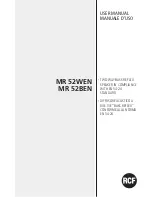
190-00734-17
GTX 335 w/GPS Installation Guidance
Rev. 1
Page 3-13
3.13 General Installation Practices
3.13.1 Circuit Protection and Power Distribution
The circuit protection device for the GTX units must be a push-pull manually resettable circuit breaker
(e.g., Klixon 7274 series circuit breakers). A single circuit breaker must be used by the GTX unit. Do not try
to put together more than one unit or system on the same circuit breaker unless specifically approved by the
manufacturer. The GTX should be connected to an avionics bus (non-essential bus) so power is supplied
when the avionics master switch is energized. If not reusing an existing circuit breaker location, the circuit
breaker should be located so it can be readily reset in flight.
3.13.2 Audio Interference
Take care to keep effects from coupled interference and ground loops to a minimum. Coupled interference
can be caused in audio system cables when they are put near large AC electric fields, AC voltage sources
and pulse equipment (e.g., strobes, spark plugs, magnetos, EL displays, CRTs, etc.). Interference can also
get into audio system cables by magnetic induction when they are put near large AC current conductors or
switched DC equipment (e.g., heaters, solenoids, fans, autopilot servos, etc.).
Ground loops are caused when there is more than one path in which return currents flow or when signal
returns have the same path as large currents from other equipment. These large currents make differences in
ground potential between the different equipment operating in the aircraft. These differences in potential can
produce an additive effect on audio panel input signals. The audio panel can receive the input signal plus an
unwanted component injected by ground differentials, a common cause of alternator-related interference.
Terminating audio shields at one end eliminates a potential ground loop injection point. The interconnect
diagrams and accompanying notes in appendix B should be followed closely to minimize interference
effects.
3.14 Cable and Wiring Considerations
NOTE
Care must be taken to sufficiently support and protect the wiring because of its thinner
insulation if MIL-W-22759/18 wire is used.
Wire selection should be in accordance with AC 43.13-1B Chapter 11, Sections 5 through 7. Wiring should
be installed in accordance with AC 43.13-1B Chapter 11, Sections 8 through 13. Follow these guidelines to
prevent damage to the aircraft and systems.
y
The wire harness should not be located near flight control cables, high electrical capacity lines or
fuel/oil lines.
y
The wire harness should be located in a protected area of the aircraft.
y
Do not route the wire harness or cables near high-energy sources.
y
Make sure the routing of the wire harness does not come in contact with sources of high heat, EMI or
RF interference.
y
Make sure there is ample space for the wire harness and mating connectors. Avoid sharp bends.
y
Do a visual inspection to make sure all coaxial cables are connected before trying to operate the
equipment.















































